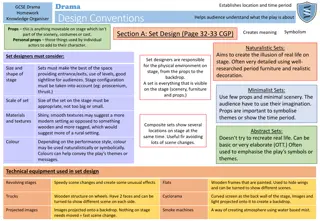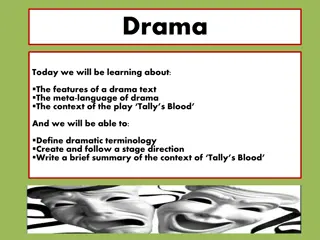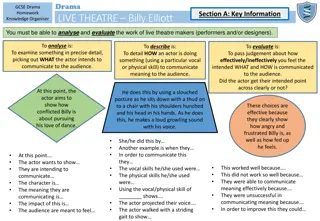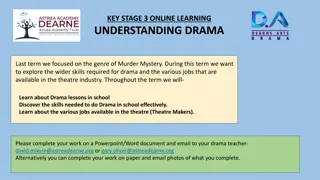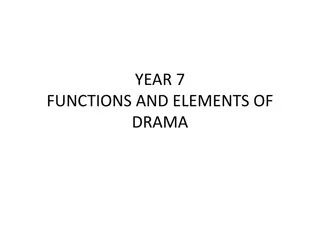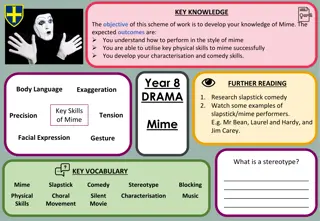Benefits of Using Drama in Language Learning
Drama activities in language learning integrate language skills, promote whole-person learning, foster self-awareness, and enhance motivation. They focus on verbal and non-verbal communication, encourage creativity and imagination, and create a positive classroom atmosphere.
Uploaded on Feb 27, 2025 | 0 Views
Download Presentation

Please find below an Image/Link to download the presentation.
The content on the website is provided AS IS for your information and personal use only. It may not be sold, licensed, or shared on other websites without obtaining consent from the author.If you encounter any issues during the download, it is possible that the publisher has removed the file from their server.
You are allowed to download the files provided on this website for personal or commercial use, subject to the condition that they are used lawfully. All files are the property of their respective owners.
The content on the website is provided AS IS for your information and personal use only. It may not be sold, licensed, or shared on other websites without obtaining consent from the author.
E N D
Presentation Transcript
Why use drama? 1. It integrates language skills in a natural way. Careful listening is a key feature. Spontaneous verbal expression is integral to most of the activities; and many of them require reading and writing, both as part of the input and the output. 2. It integrates verbal and non-verbal aspects of communication, thus bringing together both mind and body, and restoring the balance between physical and intellectual aspects of learning. 3. By fully contextualising the language, it brings the classroom interaction to life through an intense focus on meaning.
4. The emphasis on whole-person learning and multi-sensory inputs helps learners to capitalise on their strengths and to extend their range. In doing so, it offers unequalled opportunities for catering to learner differences. 5. It fosters self-awareness (and awareness of others), self-esteem and confidence; and through this, motivation is developed. 6. Motivation is likewise fostered and sustained through the variety and sense of expectancy generated by the activities. 7. There is a transfer of responsibility for learning from teacher to learners which is where it belongs.
8. It draws upon both cognitive and affective domains, thus restoring the importance of feeling as well as thinking. The affective domain can significantly enhance, inhibit or even prevent student learning. The affective domain includes factors such as student motivation, attitudes, perceptions and values. Teachers can increase their effectiveness by considering the affective domain in planning courses, delivering lectures and activities, and assessing student learning.
9. It encourages an open, exploratory style of learning where creativity and the imagination are given scope to develop. This, in turn, promotes risk-taking, which is an essential element in effective language learning. 10. It has a positive effect on classroom dynamics and atmosphere, thus facilitating the formation of a bonded group, which learns together. 11. It is an enjoyable experience. 12. It is low-resource. For most of the time, all you need is a roomful of human beings .
Standard Format for Activities Aims, Focus, Level, Time, Preparation, Procedure, Follow-on, Variation(s) Note(s).
Preparatory Discussion Many, if not most of these activities require students to work in pairs or groups to reach agreement on how they will conduct their work and how they will present the outcome. This is an essential part of the activity. There is no point in rushing into an activity for its own sake. The quality of the product, both linguistic and dramatic, depends largely on the quality of the preparatory discussion.
Use of the mother tongue There is a growing climate of opinion in favour of judicious and selective use of the mother tongue in foreign-language classes. Clearly, if taken to extremes, this can transform the foreign-language class into a mother-tongue class, which would be counterproductive and nonsensical. For drama work, it may be sensible at first to allow a limited use of the mother tongue in discussion (indeed it may be impossible to prevent it), while insisting on the use of English in the actual activity. As time goes by, however, and students become more familiar with the English expressions needed for discussion, they should be encouraged progressively to use more English.
Re-cycling of known language We need to remember that the primary function of drama techniques is to offer opportunities for use of language already learnt. It is not primarily to teach new items. This does not, of course, preclude a good deal of incidental learning, whether from teacher input (supplying a missing phrase or word) or from peers (the class as a group has much greater linguistic resources than the individuals who make it up).
The teachers role Remember that you do not need to be a trained drama expert in order to introduce drama into your teaching, though some training, especially of the voice, is desirable. For drama activities to work well, teachers themselves need to be convinced that they will work. A class rapidly senses any hesitancy or nervousness, or lack of conviction on the part of the teacher. You are the key to the success of these activities. If you do them reluctantly, or half-heartedly, it is better not to do them at all.
Non-verbal warming-up activities 1. Handshakes 2. Hand catching 3. Mirror hands 4. Numbers in your head 5. Clap around the circle 6. Swings 7. Catch the ball 8. Beat out that rhythm 9. Touch it 10. Blind










